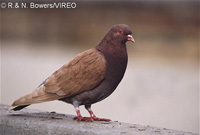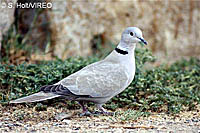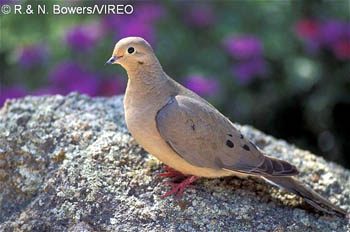Loading ...
Mourning Dove
The Mourning Dove (Zenaida macroura) is one of the ten most abundant birds in the United States. It is resident year-round across the entire lower 48 states. The slender, pinkish, gray-brown bird thrives in suburbia where it seems to spend most its time either foraging for seed on the ground under backyard feeders or roosting in flocks on telephone wires. The Mourning Dove is best known for - and takes its name from - the mournful call "coo-ahh, coo, coo, coo". Its wings also produce a distinctive whistling sound on take-off. The Mourning Dove has a long history as a game bird, and approximately thirty-five states allow hunting, without significant adverse effect on the population.
See all Mourning Dove photosField Marks:
The most distinctive mark on this tan bird is the long, tapered tail showing a margin of white spots in flight. The male Mourning Dove has a more noticeable pinkish hue on the face and breast, pink iridescence on the neck and blue tint on the crown; the belly is buff-colored. There is a bluish ring around the eye. Both sexes have black spots on the wing-covering feathers. (L 12 in.)
Distribution:
The Mourning Dove is resident throughout the continental United States and a summer resident in parts of the Canadian prairies.
Similar Species:
 |
Rock Pigeon (species account) (all photos) The Rock Pigeon has a broad, fanned tail, a heavier body, an overall gray, not pinkish tan, coloration and black wing bars. |
 |
Eurasian Collared Dove (all photos) The Eurasian Collared Dove is larger and paler and has a square tail, not a tapered, pointed tail. |
Habitat & Nesting:
Mourning Doves nest in a wide variety of trees, shrubs, and structures, and on ground surfaces. They avoid the forests.
More Information:
Mourning Doves forage almost exclusively on the ground for nuts and seeds. Falcons and raccoons are predators.

